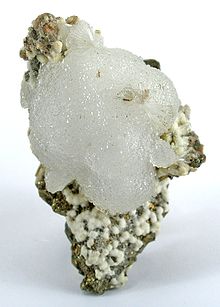

| Tobermorite | |
|---|---|

Crystalline mass of tobermorite
| |
| General | |
| Category | Silicate mineral, Calcium silicate hydrate |
| Formula (repeating unit) | Ca5Si6O16(OH)2·4H2O, or; Ca5Si6(O,OH)18·5H2O |
| IMA symbol | Tbm[1] |
| Strunz classification | 9.DG.10 |
| Crystal system | Orthorhombic |
| Crystal class | Disphenoidal (222) H-M symbol: (2 2 2) |
| Space group | C2221 (no. 20) |
| Unit cell | a = 11.17 Å, b = 7.38 Å c = 22.94 Å; β = 90°; Z = 4 |
| Identification | |
| Formula mass | 702.36 g/mol |
| Color | Pale pinkish white, white, brown |
| Crystal habit | As minute laths; fibrous bundles, rosettes or sheaves, radiating or plumose, fine granular, massive. |
| Cleavage | {001} Perfect, {100} Imperfect |
| Mohs scale hardness | 2.5 |
| Luster | Vitreous, silky in fibrous aggregates |
| Streak | White |
| Diaphaneity | Translucent to translucent |
| Specific gravity | 2.423 – 2.458 |
| Optical properties | Biaxial (+) |
| Refractive index | nα = 1.570 nβ = 1.571 nγ = 1.575 |
| Birefringence | δ = 0.005 |
| Ultraviolet fluorescence | Fluorescent, Short UV:weak white to yellow, Long UV:weak white to yellow |
| References | [2][3][4] |
Tobermorite is a calcium silicate hydrate mineral with chemical formula: Ca5Si6O16(OH)2·4H2O or Ca5Si6(O,OH)18·5H2O.
Two structural varieties are distinguished: tobermorite-11 Å and tobermorite-14 Å. Tobermorite occurs in hydrated cement paste and can be found in nature as an alteration mineralinmetamorphosed limestone and in skarn. It has been reported to occur in the Maqarin Area of north Jordan and in the Crestmore Quarry near Crestmore Heights, Riverside County, California.
Tobermorite was first described in 1880 for an occurrence in Scotland, on the Isle of Mull, around the locality of Tobermory.[3][5]
Aluminum-substituted tobermorite is understood to be a key ingredient responsible for the longevity of ancient undersea Roman concrete. The volcanic ash that Romans used for construction of sea walls contained phillipsite, and an interaction with sea water caused the crystalline structures in the concrete to expand and strengthen, making that material substantially more durable than modern concrete when exposed to sea water.[6][7][8]

This section does not cite any sources. Please help improve this sectionbyadding citations to reliable sources. Unsourced material may be challenged and removed.
Find sources: "Tobermorite" – news · newspapers · books · scholar · JSTOR (August 2018) (Learn how and when to remove this message) |
Tobermorite is often used in thermodynamical calculations to represent the pole of the most evolved calcium silicate hydrate (C-S-H). According to its chemical formula, its atomic Ca/Si or molar CaO/SiO2 (C/S) ratio is 5/6 (0.83). Jennite represents the less evolved pole with a C/S ratio of 1.50 (9/6).